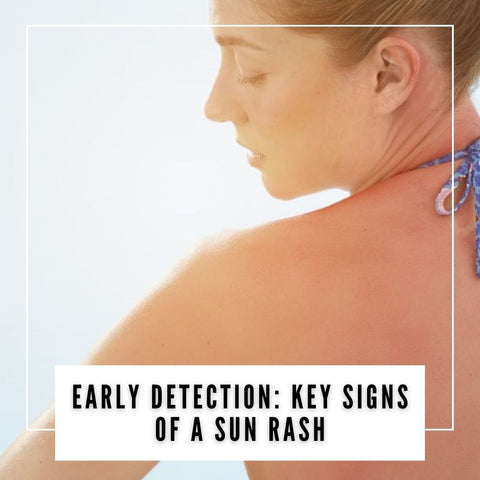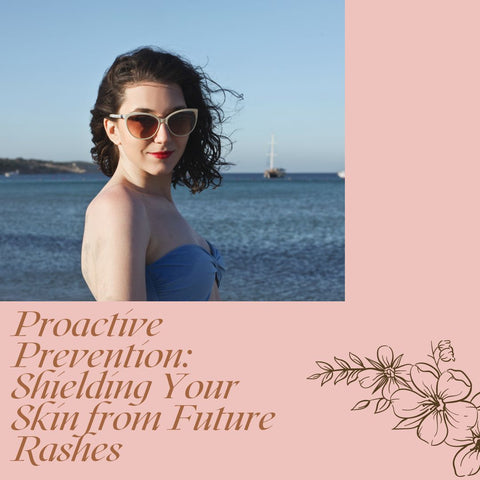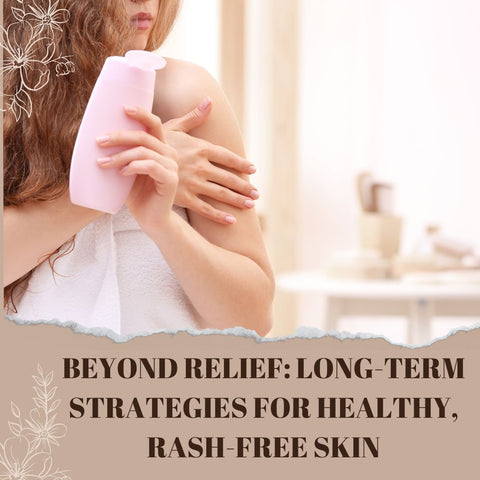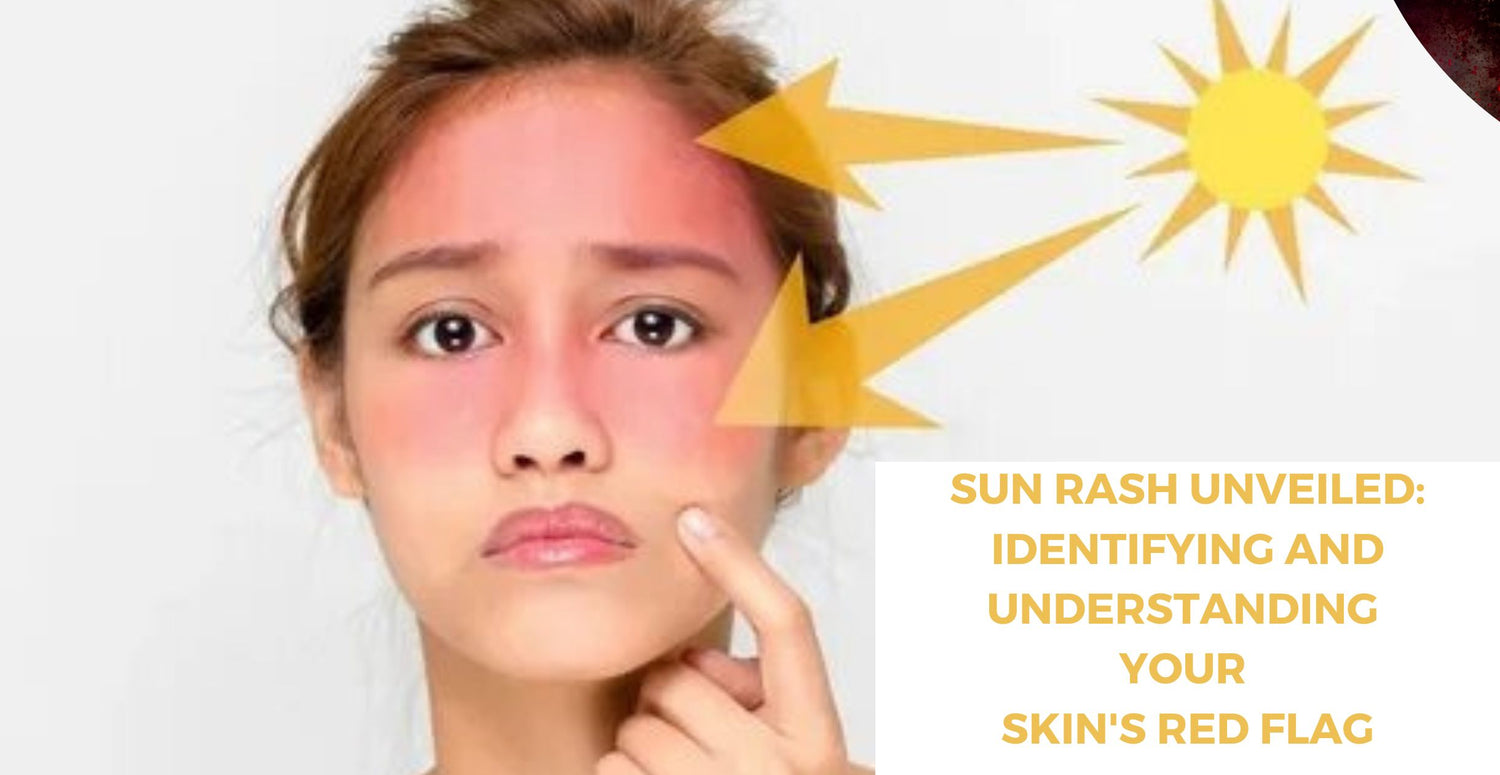"Sun rash," also known as polymorphic light eruption (PLE) or solar urticaria, is a skin condition caused by exposure to sunlight. It usually appears as red, itchy bumps or patches on the skin. This blog explains how to identify and understand this common reaction.
Early Detection: Key Signs of a Sun Rash

Detecting a sun rash early can help you manage your symptoms and avoid discomfort. Key signs to look for include redness, itching or burning sensation, bumps or blistering, patchy rash, swelling, tenderness, and symptoms after sun exposure. If you notice these symptoms after sun exposure, it's critical to take action to relieve symptoms and protect your skin from future sun exposure. Using cool compresses, soothing lotions or creams, and avoiding sun exposure during peak hours can all help relieve symptoms. If your symptoms persist or worsen, see a doctor for an accurate diagnosis and treatment.
Distinguishing Sun Rash from Other Skin Conditions
Sun rash can be difficult to distinguish from other skin conditions because of the overlapping symptoms. To distinguish sun rash from other common skin conditions, consider the following key differences:
-
Sunburn typically affects sun-exposed areas, resulting in red, painful skin that may peel or blister. Unlike sun rash, sunburn doesn't usually cause itching or small bumps.
-
Sweat duct obstructions can cause heat rash, which manifests as red spots or tiny blisters. It frequently appears in places where perspiration gets trapped, like skin folds or beneath garments. Heat rash usually goes away on its own after the skin cools down, whereas sun rash can last a long time.
-
Allergic reactions can cause redness, itching, and swelling of the skin, similar to a sunburn. However, allergic reactions can be triggered by a variety of factors other than sunlight, such as medications, foods, or insect bites.
-
Eczema is a chronic skin condition marked by red, itchy patches that can become inflamed or blistered. While sun exposure can exacerbate eczema, it usually affects areas that are not directly exposed to sunlight, such as the face, hands, elbow and knee creases.
-
Rosacea is a chronic inflammatory skin condition primarily affecting the face, resulting in redness, flushing, and visible blood vessels. Although sunlight can exacerbate rosacea symptoms, the presentation differs from sun rash, which is characterised by raised bumps or patches on sun-exposed skin.
-
Certain medical conditions, such as lupus, porphyria, or polymorphic light eruption (PLE), can cause excessive sensitivity to sunlight, resulting in a rash or other skin symptoms when exposed. These conditions may necessitate medical evaluation and management to ascertain the underlying cause and appropriate treatment.
Common Symptoms: What to Look For
Sun rash, also known as polymorphic light eruption (PLE) or solar urticaria, is characterised by redness (erythema), itching (pruritis), bumps or papules, blistering, patchy rash, burning or stinging sensation, swelling (edoema), tenderness, and symptoms after sun exposure. It is important to note that the severity and duration of symptoms can vary depending on the individual's sensitivity to sunlight and the amount of exposure. If you experience these symptoms after being in the sun, seek shade, apply cool compresses, and use soothing lotions or creams to relieve your discomfort. If your symptoms persist or worsen, see a doctor for an accurate diagnosis and treatment.
Photosensitivity: Understanding Your Skin's Reaction to the Sun
Photosensitivity is an abnormal sensitivity or reaction of the skin to sunlight or specific types of artificial lighting. People with photosensitive skin may have a variety of reactions, ranging from mild redness and itching to severe blistering and rash formation. Here's a more detailed understanding of photosensitivity and its causes:
-
Types of Photosensitivity: This occurs when certain substances, such as medications or skincare products, react with sunlight, resulting in an allergic reaction on the skin. In this kind of reaction, the skin is more vulnerable to UV damage from certain medications or chemicals, which causes a localised reaction.
-
Causes of Photosensitivity: Certain medications, such as antibiotics, nonsteroidal anti-inflammatory drugs (NSAIDs), diuretics, and antifungal drugs, can cause increased sensitivity to sunlight. Fragrances, preservatives, and certain essential oils found in skincare products can cause photoallergic reactions when exposed to sunlight. Certain medical conditions, including lupus, polymorphic light eruption (PLE), porphyria, and some types of dermatitis, can cause photosensitivity as a symptom. Some people may be genetically predisposed to photosensitivity, making them more vulnerable to sun-induced skin reactions.
-
Symptoms of Photosensitivity: Redness (erythema), Itching or burning sensation, Swelling (edema), Blisters or rash formation, Darkening or hyperpigmentation of the skin and Peeling or scaling of the skin.
-
Prevention and Management: Avoiding sunlight during peak hours (10 a.m. to 4 p.m.) and seeking shade when outside. Wear protective clothing, such as wide-brimmed hats, long-sleeved shirts, and UV-protected sunglasses. Apply broad-spectrum sunscreen with a high SPF (sun protection factor) to any exposed skin areas. Checking medication labels for photosensitivity warnings and discussing any concerns with healthcare providers. Using hypoallergenic and fragrance-free skincare products to reduce the likelihood of photoallergic reactions.
-
Seeking Medical Advice: If you have persistent or severe symptoms of photosensitivity, you should see a doctor for an evaluation and proper treatment. A dermatologist can diagnose the underlying cause of photosensitivity and recommend treatments or preventive measures that are tailored to your specific needs.
Immediate and Effective Relief: Treating a Sun Rash

Treating a sun rash involves soothing the skin, reducing inflammation, and relieving discomfort. Here are some immediate and effective relief measures for treating a sun rash:
-
Apply cool, damp compresses to the affected areas to help soothe inflammation and alleviate itching. Avoid using ice directly on the skin to prevent further irritation.
-
Drink plenty of water to stay hydrated, as sun exposure can dehydrate the skin and exacerbate symptoms. Hydration can help to promote skin healing and reduce inflammation..
-
Apply pure aloe vera gel to the affected skin to relieve inflammation, reduce redness, and promote healing. When applied to the affected areas, calamine lotion can provide relief from itching and a cooling sensation. Over-the-counter hydrocortisone cream can help reduce the inflammation and itching caused by sun rash. Follow the directions on the product label and avoid prolonged use without medical supervision.
-
Taking a cool bath with colloidal oatmeal or adding oatmeal to bathwater can help soothe irritated skin and relieve itching. Soak in the bath for 15-20 minutes and pat your skin dry gently afterward.
-
Apply a gentle, fragrance-free moisturizer to the affected areas to help keep the skin hydrated and prevent further irritation. Look for moisturizers containing ingredients like ceramides or hyaluronic acid.
-
Oral antihistamines, such as diphenhydramine (Benadryl) or loratadine (Claritin), can help reduce itching and inflammation associated with sun rash. Follow the dosage instructions provided on the packaging or consult a healthcare professional for guidance.
-
Protect the affected skin from further sun exposure by wearing loose-fitting clothing that covers the affected areas and staying in shaded areas when outdoors.
-
If the sun rash is severe, persistent, or accompanied by other concerning symptoms such as fever or blistering, seek medical evaluation. A healthcare professional can provide appropriate treatment and advice based on the severity of your symptoms.
First-Aid Measures for Quick Relief
Here are some first-aid measures you can take to get rid of a sun rash quickly: cool compresses, hydration, aloe vera gel, over-the-counter anti-itch creams, oral antihistamines, avoid sun exposure, avoid harsh soaps and perfumes, keep skin moisturised, avoid scratching, rest, and elevate. Consult a doctor if the sun rash is severe, lasts more than a few days, or is accompanied by other symptoms such as fever or blistering. A healthcare professional can conduct additional evaluations and recommend appropriate treatment options.
Over-the-Counter Solutions and When to Use Them
Over-the-counter (OTC) medications can effectively treat mild to moderate sun rash symptoms. Here are some common over-the-counter products and when to use them.
-
Hydrocortisone Cream: Hydrocortisone cream is a mild corticosteroid that can help reduce inflammation, itching, and redness caused by sun rash. Use hydrocortisone cream as directed on the package, applying a thin layer to the affected area 2-3 times per day. Avoid prolonged use without medical supervision, especially on large areas of skin or for long periods.
-
Calamine Lotion: Calamine lotion contains ingredients such as zinc oxide and ferric oxide, both of which have soothing and anti-itch properties. It can help relieve itching and provide a cooling sensation when applied to the affected skin. Before using, give the bottle a good shake, then follow the directions on the packaging to apply calamine lotion to the rash as needed.
-
Antihistamine Creams: Over-the-counter antihistamine creams, like cetirizine (Zyrtec) cream or diphenhydramine (Benadryl) cream, can help reduce sun rash-related itching and inflammation. As instructed on the package, apply a thin layer of antihistamine cream to the afflicted area two or three times a day. Antihistamine creams should not be applied to skin that is broken or damaged.
-
Oral Antihistamines: These medications, which include cetirizine (Zyrtec), loratadine (Claritin), and diphenhydramine (Benadryl), can help lessen symptoms of itching, redness, and inflammation by acting on the inside. Take oral antihistamines exactly as directed on the package or as prescribed by a healthcare professional. They are especially effective at treating widespread or persistent sun rash symptoms.
-
Aloe Vera Gel: This natural remedy has soothing and anti-inflammatory properties. Apply pure aloe vera gel directly to the affected skin to alleviate redness, inflammation, and itching. You can apply aloe vera gel as needed throughout the day for relief.
-
Cooling Gels or Sprays: Some OTC cooling gels or sprays contain ingredients such as menthol or camphor, which can provide a cooling sensation while also relieving itching and discomfort. Follow the product label's instructions and apply the cooling gel or spray to the affected area as needed to provide relief.
Home Remedies: Natural Approaches to Soothe Your Skin
Natural home remedies can provide gentle relief from sun rash symptoms. Here are some effective natural remedies for soothing your skin:
-
Cold compresses: Apply cold compresses to the affected area to help reduce inflammation, itching, and pain. Before applying ice packs to the skin, wrap them in a towel or a clean cloth soaked in cold water. Apply the cold compress for 10-15 minutes at a time, several times per day if necessary.
-
Aloe Vera Gel: Aloe vera has anti-inflammatory and cooling properties that can help relieve sunburn and rash. Apply pure aloe vera gel directly to the affected skin to alleviate redness, inflammation, and itching. You can use fresh aloe vera gel from the plant or buy commercially available pure aloe vera gel.
-
Oatmeal Bath: An oatmeal bath can help relieve the itching and inflammation caused by sun rash. Add colloidal oatmeal or finely ground oatmeal to lukewarm bath water and soak for 15-20 minutes. To prevent further irritation, gently pat your skin dry.
-
Cooling Cucumber: Cucumber's natural cooling and anti-inflammatory properties can help soothe sensitive skin. Slice a cucumber and place it in the refrigerator to chill. Apply cold cucumber slices to the affected skin to provide immediate relief from itching and inflammation.
-
Coconut Oil: Sunburn and sun rash can be relieved by the moisturising and anti-inflammatory qualities of coconut oil. To help hydrate the affected skin and lessen inflammation, apply extra-virgin coconut oil. If your skin is oily or prone to acne, stay away from coconut oil.
-
Apple Cider Vinegar: Sunburn-related itching and inflammation can be reduced with diluted apple cider vinegar. Apply a solution made of equal parts apple cider vinegar and water to the afflicted area of skin using a cotton ball or gentle cloth. Before washing it off with lukewarm water, let it dry.
-
Green Tea: Compounds with antioxidant and anti-inflammatory properties found in green tea can help relieve sunburn and sun rash. Make a cup of green tea and let it settle fully. For relief, apply the cooled tea to the afflicted area with a cotton ball or soft cloth.
-
Honey: Honey's inherent antibacterial and anti-inflammatory qualities can aid in the healing of irritated skin. Apply a thin layer of raw honey to the affected area and let it sit for 10-15 minutes before rinsing with lukewarm water.
Remember to patch-test any new natural remedies on a small area of skin before using them on a larger scale to avoid an allergic reaction. If your symptoms persist or worsen, or if you have severe symptoms like blistering, fever, or difficulty breathing, seek medical attention right away.
Proactive Prevention: Shielding Your Skin from Future Rashes

The best defence against sun-induced rashes on your skin is proactive prevention. The following techniques can help shield your skin and reduce your chance of developing a sun rash:
-
Use a broad-spectrum sunscreen with an SPF (sun protection factor) of 30 or higher on all exposed skin, including the face, neck, ears, and hands. Reapply sunscreen every two hours, or more often if swimming or sweating.
-
Limit your sun exposure, particularly between 10 a.m. and 4 p.m. When outside, seek shade under umbrellas, trees, or other structures to reduce direct UV exposure.
-
Cover up with tightly woven UV-protective clothing. Choose lightweight, long-sleeved shirts, trousers and wide-brimmed hats to protect your skin from the sun.
-
Wear sunglasses that completely block UVA and UVB rays to protect your eyes and the delicate skin surrounding them. Look for sunglasses labelled as UV protective.
-
Tanning beds and sunlamps emit harmful UV radiation, increasing the risk of sunburn and skin damage. Avoid using them.
-
Drink plenty of water to stay hydrated, as dehydration can increase your risk of sun sensitivity and sunburn. Aim for at least eight glasses of water per day, and more if you spend time outside in the sun.
-
Be aware of medications that can cause increased sensitivity to sunlight (photosensitivity). Check prescription and over-the-counter medication labels for sun sensitivity warnings, and if you have any concerns, speak with your doctor.
-
To protect your lips from sunburn and sun damage, apply an SPF-containing lip balm. Choose a lip balm that protects against both UVA and UVB rays.
-
UV rays can bounce off surfaces such as water, sand, snow, and concrete, increasing sunlight exposure. Take extra precautions when near reflective surfaces, and wear sunscreen and protective clothing appropriately.
-
Perform regular skin checks to look for changes or abnormalities in moles, freckles, and other skin lesions. Consult a dermatologist if you notice any unusual changes, such as new or changing moles, or if you have a history of skin cancer.
Sunscreen Selection: Protecting Sensitive Skin
Protecting sensitive skin from the sun necessitates careful selection of sunscreen products that are gentle and appropriate for sensitive skin types. Here's how to choose and apply sunscreen effectively to sensitive skin:
-
Mineral Sunscreens: Look for sunscreens that use zinc oxide or titanium dioxide as active ingredients. These mineral-based sunscreens are less likely to cause irritation or allergic reactions than chemical sunscreens.
-
Broad-Spectrum Protection: Select a sunscreen that blocks both UVA and UVB rays. This protects your skin against sunburn, premature ageing, and skin cancer.
-
Fragrance-Free Formulas: Choose fragrance-free or hypoallergenic sunscreens to reduce the risk of irritation for sensitive skin. Fragrances can cause allergic reactions and irritate sensitive skin.
-
Oil-Free and Non-Comedogenic: If you have oily or acne-prone skin, look for sunscreens that are oil-free and non-comedogenic, which will not clog pores or worsen acne breakouts.
-
SPF (Sun Protection Factor): For adequate protection, use a sunscreen with SPF 30 or higher. Higher SPFs provide more protection, but no sunscreen can guarantee 100% protection. Reapply sunscreen every two hours, or more often if swimming or sweating.
-
Water-Resistant Formulas: If you plan to swim or sweat, use a sunscreen that is water-resistant for up to 40 or 80 minutes. Reapply after swimming or sweating, following the instructions on the product label.
-
Patch Test New Products: Before using sunscreen on your entire body, perform a patch test on a small area of skin to check for allergic reactions or irritation. Apply a small amount of sunscreen to the inside of your forearm and wait 24 hours to see if any adverse reactions occur.
-
Apply Broadly and Evenly: Cover all exposed skin, including the hands, neck, ears, and face, with a liberal layer of sunscreen. Be sure to cover any areas that may be easily overlooked, such as the tops of the feet and the back of the neck.
-
Reapply Regularly: Reapply sunscreen every two hours, or more frequently if swimming, sweating heavily, or toweling off. Even water-resistant sunscreens can wear off over time, so it's essential to reapply regularly for continued protection.
-
Other Sun Protection Measures: In addition to sunscreen, use other sun protection measures such as seeking shade, wearing protective clothing, hats, and sunglasses, and avoiding sun exposure during peak hours.
The Role of Clothing and Accessories in Sun Protection
Clothing and accessories play an important role in sun protection by forming a physical barrier between your skin and the sun's harmful UV (ultraviolet) rays. Long-sleeved shirts and pants, dark and dense fabrics, wide-brimmed hats, sunglasses, UV-protective clothing, tightly woven fabrics, sun sleeves and gloves, UV-protective umbrellas, UPF swimwear, and cover-up accessories are all examples of clothing and accessories that can help shield you from sun damage. Sun-protective clothing and accessories can help you reduce sun exposure and the risk of sunburn, premature ageing, and skin cancer.
Lifestyle Adjustments: Minimizing Your Risk of Sun Rash
Making lifestyle changes to reduce your overall sun exposure and protect your skin from harmful UV radiation can help reduce your risk of developing sun rash. Here are some lifestyle changes you can make to reduce your chances of developing sun rash:
-
Avoid prolonged sun exposure, especially during peak hours of 10 a.m. to 4 p.m. If possible, schedule outdoor activities for early morning or late afternoon, when the sun is less intense.
-
When outdoors, seek shade under trees, umbrellas, or canopies to reduce direct sun exposure. Shade creates a natural barrier against UV radiation, protecting your skin from sunburn and rash.
-
To protect your skin from UV rays, wear lightweight long-sleeved shirts, pants and wide-brimmed hats. Choose clothing made of tightly woven fabrics with a UPF (Ultraviolet Protection Factor) rating for added sun protection.
-
Use a broad-spectrum sunscreen with an SPF (Sun Protection Factor) of 30 or higher on all exposed skin, including the face, neck, ears, and hands. Reapply sunscreen every two hours, or more often if swimming or sweating.
-
Choose outdoor activities that reduce sun exposure, such as hiking on shaded trails, picnicking under trees, or playing sports on covered surfaces such as tennis courts or golf courses.
-
Drink plenty of water to stay hydrated, especially if you are spending time outdoors in the sun. Dehydration increases your risk of sun sensitivity and sunburn, so replenish fluids regularly.
-
Be aware of medications that can cause increased sensitivity to sunlight (photosensitivity). Check prescription and over-the-counter medication labels for sun sensitivity warnings, and if you have any concerns, speak with your doctor.
-
Avoid using tanning beds or sunlamps, as they emit harmful UV radiation and increase the risk of sunburn, sun rash, and skin damage. For a sun-kissed glow, use safer alternatives like self-tanning lotions or sprays.
-
Wear sunglasses with 100% UV protection to protect your eyes from harmful UV rays. UV-blocking sunglasses help reduce the risk of eye damage and certain eye conditions caused by sun exposure.
-
Perform regular skin checks to look for changes or abnormalities in moles, freckles, and other skin lesions. Seek medical attention right away if you notice any unusual changes or develop a persistent rash after sun exposure.
Beyond Relief: Long-Term Strategies for Healthy, Rash-Free Skin

To maintain healthy, rash-free skin over time, you must follow a comprehensive skincare routine and incorporate sun-safe practices into your daily life. Long-term strategies for achieving and maintaining healthy skin include daily sun protection, protective clothing, seeking shade, staying hydrated, gentle skincare products, moisturising regularly, avoiding harsh exfoliation, managing stress, eating a healthy diet, and getting regular skin checks. By incorporating these long-term strategies into your skincare routine and lifestyle, you can promote healthy, rash-free skin while lowering your risk of sun damage, irritation, and other skin issues over time.
















